Improving Operational Short- to Medium-Range (SR2MR) Streamflow Forecasts in the Upper Zambezi Basin and Its Sub-Basins Using Variational Ensemble Forecasting
Abstract
:1. Introduction
1.1. Decisions and Limitations of Hydrologic Forecasting
1.2. Knowledge Gaps and Justification of the Study
1.3. Variational Ensemble Forecasting (VEF) to Improve Operational Streamflow Forecasts
1.4. Purpose of This Paper
2. Methods
2.1. The Upper Zambezi River Basin (UZRB) Domain
| Country | Streamgauge | South Latitude | East Longitude | Area (km²) | Altitude (m.a.s.l.) | Average Flow (m3/s) | Period | Missing (%) | HFS |
|---|---|---|---|---|---|---|---|---|---|
| Zambia | Kalene Hill Road Bridge | −11.13 | 24.25 | 764 | 1261 | 12.3 | 1977–2004 | 34.81 | No |
| Zambia | Chivata Village | −13.33 | 23.15 | 3354 | 1065 | 17.4 | 1962–2004 | 23.32 | Yes |
| Zambia | Luanginga-Kalabo | −14.96 | 22.68 | 34,621 | 1021 | 59.0 | 1958–2004 | 8.94 | Yes |
| Zambia | Kabompo Pontoon | −13.60 | 24.21 | 42,740 | 1029 | 252.2 | 1990–2005 | 51.04 | Yes |
| Zambia | Lukulu | −14.38 | 23.233 | 206,531 | 1012 | 772.0 | 1950–2004 | 12.44 | Yes |
| Zambia | Senanga | −16.11 | 23.25 | 284,538 | 992 | 972.6 | 1947–2004 | 8.40 | Yes |
| Namibia | Katima Mulilo | −17.48 | 24.3 | 339,521 | 746 | 1174.5 | 1942–2017 | 13.54 | Yes |
2.2. Forecasting Timescales and Water Management Activities
2.3. The Operational Context of a Hydrologic Modeling Paradigm
2.4. Selection of Hydro Climatological Forcings
2.5. Hydrologic Models for Operational HFS
2.6. Calibration of Models Included in the HFS
2.7. Operational Variational Ensemble Forecasting (VEF)
- where, is a Multiproduct, Multimodel, and Multiparameter Variational Ensemble Streamflow Forecast for the forecast period TF.
- is a family of hypothetical ensemble components for the warmup period TW and used to forecast the period TF.
- is a hypothesis of the hydrologic process from a family of input data i, hydrologic model j, and parameter set k, about the HFS for the forecast period TF.
- is the streamflow prediction i, j, k about the HFS response for the forecast period TF.
- is a hypothesis of the input data from a family of input data i about the HFS for the forecast period TF.
- is a hypothesis of the hydrologic process from a family of hydrologic models j and for the warmup period TW.
- is a hypothesis of the parameter sets from a family of parameter sets k for the warmup period TW.
- is the control variable for the forecast period TF.
- is a family of input data i about the HFS for the forecast period TF.
- is a family of input data i about the HFS for the warmup period TW.
- is the model structure j for the warmup period TW.
- is the parameter set k for the warmup period TW.
- is a family of parameter sets k for the warmup period TW.
2.8. Strategies to Reduce Uncertainty and Improve VEF in an Operational Environment
3. Results
3.1. Strategy 1: Hydrological Pre-Processing (HPR)
3.2. Strategy 2: Hydrological Processing (HP)
3.3. Evaluating Pre-Operational SR2MR Streamflow Forecasts
3.4. Strategy 3: Hydrologic Post-Processing (HPP) for Raw Streamflow Forecasts
4. Discussion
5. Conclusions
Author Contributions
Funding
Acknowledgments
Conflicts of Interest
Appendix A. Hydrologic Models Used for SR2MR Streamflow Forecasting in the UZRB
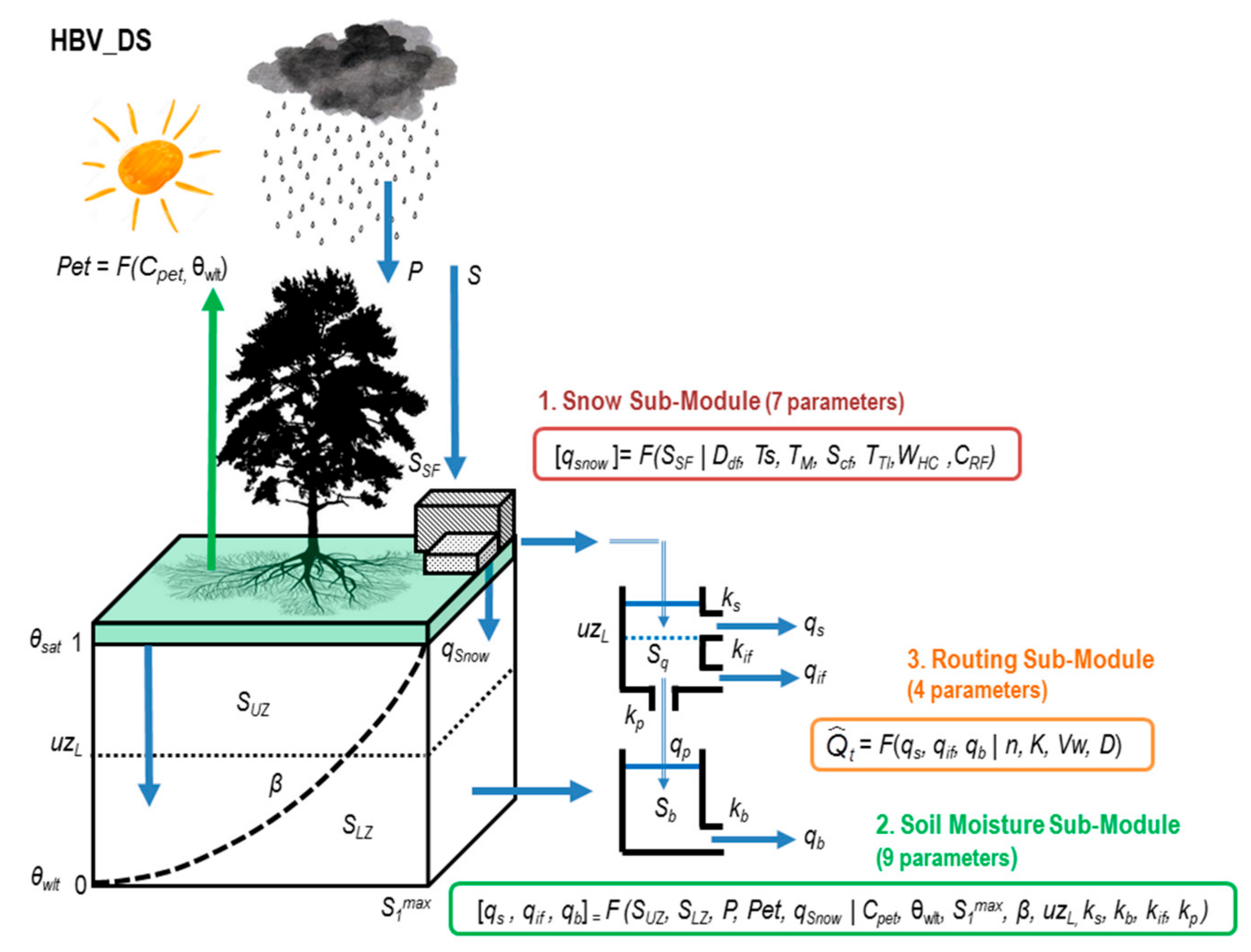
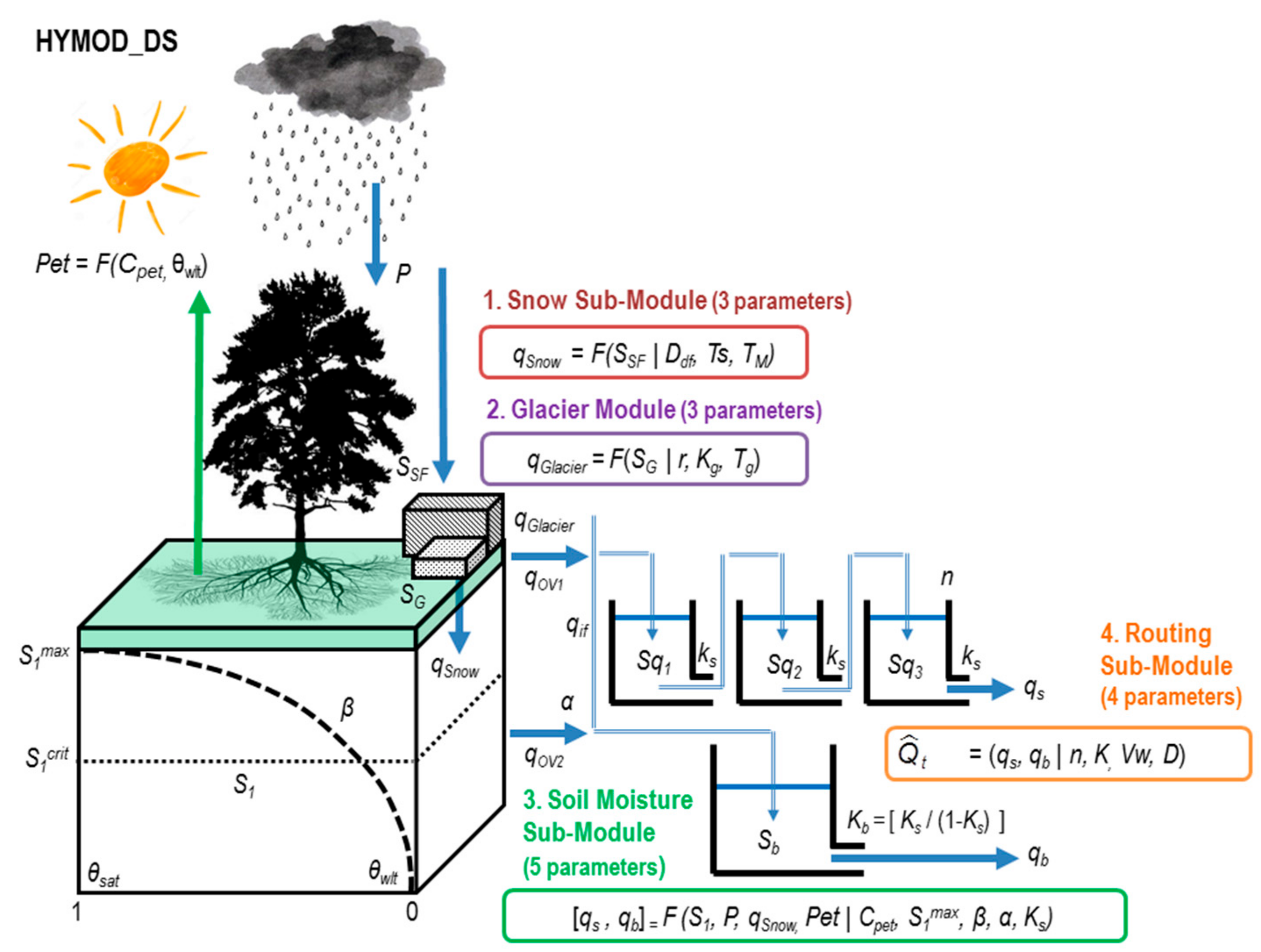
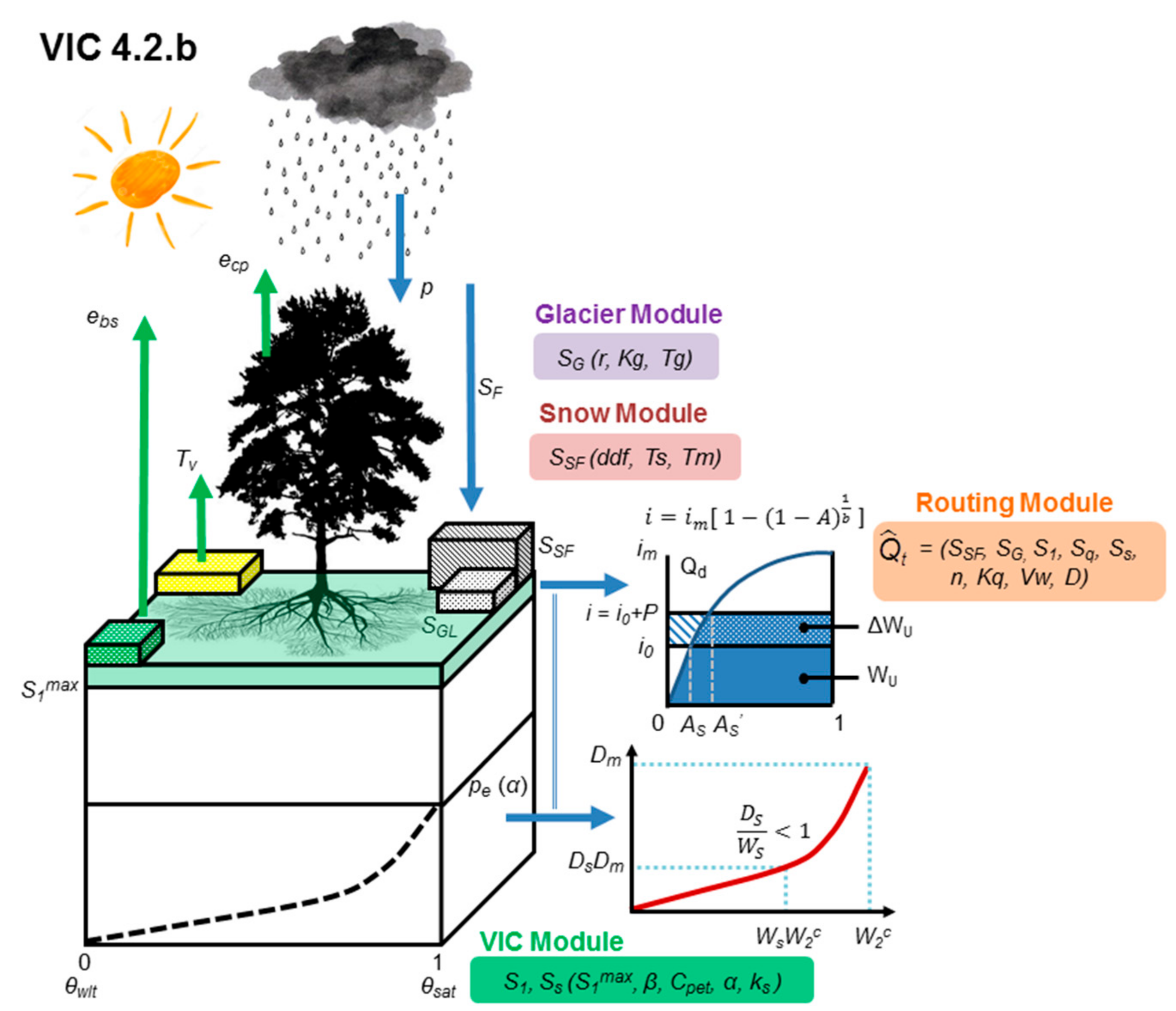
| Module | Parameters | Description | Range | Units | Model |
|---|---|---|---|---|---|
| Soil Moisture | Cpet | Proportionality Coefficient of Hamon Potential Evapotranspiration | 0.1–2 | non-dim | HVB–HYMOD |
| S1max | Maximum storage capacity of soil moisture accounting tank | 5–1500 | (mm) | HVB–HYMOD | |
| β | Shape parameter of the storage capacity distribution function | 0.01–1.99 | non-dim | HVB–HYMOD | |
| α | Split parameter for quick and slow components | 0.01–0.99 | non-dim | HYMOD | |
| θwlt | Soil Permanent Wilting Point (limiting soil moisture for PET occurrence) | 0.1–1 | non-dim | HBV | |
| uzL | Upper reservoir water level for quick runoff occurrence | 0–1000 | mm | HBV | |
| Ks | Recession constant for quickflow in the upper reservoir | 0.01–0.99 | day−1 | HVB–HYMOD | |
| Kb | Recession constant for slowflow in the lower reservoir | 0.0001–0.99 | day−1 | HVB–HYMOD | |
| Kif | Recession constant for interflow in the upper reservoir | 0.001–0.15 | day−1 | HBV | |
| Kp | Flow rate for percolation between the upper and lower reservoir | 0–3 | mm day−1 | HBV | |
| bi | Shape parameter of the Variable Infiltration Capacity curve | 0–0.4 | non-dim | VIC | |
| D2 | Second Soil Layer Thickness | 0.1–1.5 | m | VIC | |
| D3 | Third Soil Layer Thickness | 0.1–1.5 | m | VIC | |
| DSmax | Maximum Baseflow Velocity | 0–30 | mm day−1 | VIC | |
| DS | Fraction of Maximum Baseflow Velocity | 0–1 | non-dim | VIC | |
| WS | Fraction of Maximum Soil Moisture content of the third soil layer | 0–1 | non-dim | VIC | |
| Snow | Ddf | Degree-Day Factor | 0.001–10.0 | mm °C day−1 | HVB–HYMOD |
| Scf | Snowfall Correction Factor | 0.4–1 | non-dim | HBV | |
| TS | Temperature threshold for snow falling | 0–5 | °C | HVB–HYMOD | |
| TM | Temperature threshold for snowmelt | 0–5 | °C | HVB–HYMOD | |
| TTI | Temperature interval for mixture of snow and rain | 0–5 | °C | HBV | |
| WHC | Liquid water holding capacity of the snowpack | 0–0.2 | non-dim | HBV | |
| CRF | Refreezing coefficient of the liquid water in snow | 0–1 | non-dim | HBV | |
| Glacier | r | Glacier melt factor | 1–2 | non-dim | HYMOD |
| Kg | Glacier reservoir release coefficient | 0.01–0.99 | non-dim | HYMOD | |
| Tg | Glacier melt temperature threshold | 0–10 | °C | HYMOD | |
| Routing | n | Grid Unit Hydrograph parameter (number of linear reservoirs) | 1–99 | non-dim | HVB–HYMOD |
| Kq | Grid Unit Hydrograph parameter (reservoir storage constant) | 0.01–0.99 | day−1 | HVB–HYMOD | |
| Vw | Wave velocity in the linearized Saint-Venant equation | 0.5–5.0 | m s−1 | HYMOD | |
| D | Diffusivity in the linearized Saint-Venant equation | 200–4000 | m2 s−1 | HYMOD |
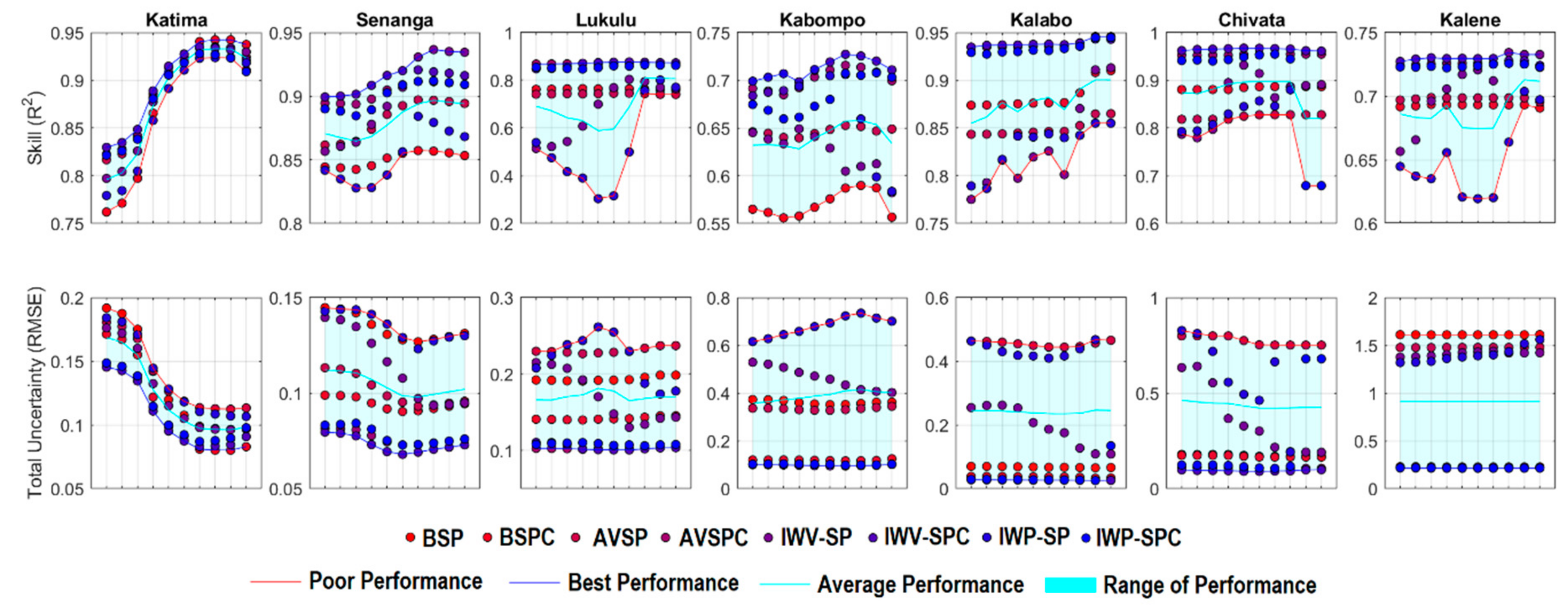
References
- Bartholomé, E.; Belward, A.S. GLC2000: A new approach to global land cover mapping from Earth observation data. Int. J. Remote Sens. 2005, 26, 1959–1977. [Google Scholar] [CrossRef]
- Lehner, B.; Verdin, K.; Jarvis, A. New global hydrography derived from spaceborne elevation data. Eos 2011, 89, 93–94. [Google Scholar] [CrossRef]
- Meier, P.; Frömelt, A.; Kinzelbach, W. Hydrological real-time modelling in the Zambezi river basin using satellite-based soil moisture and rainfall data. Hydrol. Earth Syst. Sci. 2011, 15, 999–1008. [Google Scholar] [CrossRef] [Green Version]
- Meier, P. Real-Time Hydrologic Modelling and Floodplain Modelling in the Kafue River Basin, Zambia. Ph.D. Thesis, ETH Zurich, Zurich, Switerland, 2012. [Google Scholar]
- Liechti, C.T.; Matos, J.P.; Ferràs Segura, D.; Boillat, J.L.; Schleiss, A.J. Hydrological modelling of the Zambezi River Basin taking into account floodplain behaviour by a modified reservoir approach. Int. J. River Basin Manag. 2014, 12, 29–41. [Google Scholar] [CrossRef] [Green Version]
- Arnold, J.G.; Moriasi, D.N.; Gassman, P.W.; Abbaspour, K.C.; White, M.J.; Srinivasan, R.; Kannan, N. SWAT: Model use, calibration, and validation. Trans. ASABE 2012, 55, 1491–1508. [Google Scholar] [CrossRef]
- Beck, L.; Bernauer, T. How will combined changes in water demand and climate affect water availability in the Zambezi River basin? Glob. Environ. Chang. 2011, 21, 1061–1072. [Google Scholar] [CrossRef]
- Michailovsky, C.I.; McEnnis, S.; Berry, P.A.M.; Smith, R.; Bauer-Gottwein, P. River monitoring from satellite radar altimetry in the Zambezi River basin. Hydrol. Earth Syst. Sci. 2012, 16, 2181–2192. [Google Scholar] [CrossRef] [Green Version]
- Nones, M.; Ronco, P.; Di Silvio, G. Modelling the impact of large impoundments on the Lower Zambezi River. Int. J. River Basin Manag. 2013, 11, 221–236. [Google Scholar] [CrossRef]
- Gumindoga, W.; Makurira, H.; Phiri, M.; Nhapi, I. Estimating runoff from ungauged catchments for reservoir water balance in the Lower Middle Zambezi Basin. Water SA 2016, 42, 641–649. [Google Scholar] [CrossRef] [Green Version]
- Ndhlovu, G.Z.; Woyessa, Y.E. Evaluation of Streamflow under Climate Change in the Zambezi River Basin of Southern Africa. Water 2021, 13, 3114. [Google Scholar] [CrossRef]
- Gumindoga, W.; Rientjes TH, M.; Haile, A.T.; Reggiani, P.; Makurira, H. Propagation of CMORPH rainfall errors to REW streamflow simulation mismatch in the Upper Zambezi Basin. J. Hydrol. Reg. Stud. 2021, 38, 100966. [Google Scholar] [CrossRef]
- Valdés-Pineda, R.; Demaría, E.M.C.; Valdés, J.B.; Wi, S.; Serrat-Capdevilla, A. Bias correction of daily satellite-based rainfall estimates for hydrologic forecasting in the Upper Zambezi, Africa. Hydrol. Earth Syst. Sci. 2016, 1–28. [Google Scholar] [CrossRef] [Green Version]
- Roy, T.; Serrat-Capdevila, A.; Gupta, H.; Valdes, J. A platform for probabilistic Multimodel and Multiproduct Streamflow Forecasting. Water Resour. Res. 2017, 53, 376–399. [Google Scholar] [CrossRef] [Green Version]
- Beven, K.; Freer, J. A dynamic topmodel. Hydrol. Processes 2001, 15, 1993–2011. [Google Scholar] [CrossRef]
- Clark, M.P.; Slater, A.G.; Rupp, D.E.; Woods, R.A.; Vrugt, J.A.; Gupta, H.V.; Hay, L.E. Framework for Understanding Structural Errors (FUSE): A modular framework to diagnose differences between hydrological models. Water Resour. Res. 2008, 44. [Google Scholar] [CrossRef]
- Velázquez, J.A.; Anctil, F.; Ramos, M.H.; Perrin, C. Can a multi-model approach improve hydrological ensemble forecasting? A study on 29 French catchments using 16 hydrological model structures. Adv. Geosci. 2011, 29, 33–42. [Google Scholar] [CrossRef] [Green Version]
- Seiller, G.; Anctil, F.; Perrin, C. Multimodel evaluation of twenty lumped hydrological models under contrasted climate conditions. Hydrol. Earth Syst. Sci. 2012, 16, 1171–1189. [Google Scholar] [CrossRef] [Green Version]
- Wood, A.W.; Lettenmaier, D.P. An ensemble approach for attribution of hydrologic prediction uncertainty. Geophys. Res. Lett. 2008, 35. [Google Scholar] [CrossRef] [Green Version]
- Wood, A.W.; Hopson, T.; Newman, A.; Brekke, L.; Arnold, J.; Clark, M. Quantifying streamflow forecast skill elasticity to initial condition and climate prediction skill. J. Hydrometeorol. 2016, 17, 651–668. [Google Scholar] [CrossRef]
- Roy, T.; Valdés, J.B.; Serrat-Capdevila, A.; Durcik, M.; Demaria, E.M.; Valdés-Pineda, R.; Gupta, H.V. Detailed Overview of the multimodel multiproduct streamflow forecasting platform. J. Appl. Water Eng. Res. 2020, 8, 277–289. [Google Scholar] [CrossRef]
- Valdés-Pineda, R.; Valdés, J.B.; Wi, S.; Serrat-Capdevila, A.; Tirthankar, R.; Demaria, E.; Durcik, M. Operational Daily Streamflow Forecasts by coupling Variational Ensemble Forecasting and Machine Learning (VEF-ML) approaches. In Proceedings of the EGU General Assembly Conference Abstracts, Virtual, 19–30 April 2021; p. EGU21-14087. [Google Scholar]
- Tumbare, M.J.; Mukosa CF, G. A brief history of the creation of the Zambezi River Autority. In Management of River Basins and Dams; CRC Press: Boca Raton, FL, USA, 2021; pp. 43–47. [Google Scholar]
- Hamududu, B.H.; Killingtveit, A. Hydropower production in future climate scenarios; the case for the Zambezi River. Energies 2016, 9, 502. [Google Scholar] [CrossRef] [Green Version]
- Funk, C.C.; Peterson, P.J.; Landsfeld, M.F.; Pedreros, D.H.; Verdin, J.P.; Rowland, J.D.; Verdin, A.P. A Quasi-Global Precipitation Time Series for Drought Monitoring; US Geological Survey Data Series 832; Earth Resources Observation and Science (EROS) Center U.S. Geological Survey: Sioux Falls, SD, USA, 2014; pp. 1–12. [Google Scholar]
- Funk, C.; Peterson, P.; Landsfeld, M.; Pedreros, D.; Verdin, J.; Shukla, S.; Michaelsen, J. The climate hazards infrared precipitation with stations—A new environmental record for monitoring extremes. Sci. Data 2015, 2, 150066. [Google Scholar] [CrossRef] [Green Version]
- Sheffield, J.; Goteti, G.; Wood, E.F. Development of a 50-year high-resolution global dataset of meteorological forcings for land surface modeling. J. Clim. 2006, 19, 3088–3111. [Google Scholar] [CrossRef] [Green Version]
- Huffman, G.J.; Bolvin, D.T.; Nelkin, E.J.; Wolff, D.B.; Adler, R.F.; Gu, G.; Stocker, E.F. The TRMM multisatellite precipitation analysis (TMPA): Quasi-global, multiyear, combined-sensor precipitation estimates at fine scales. J. Hydrometeorol. 2007, 8, 38–55. [Google Scholar] [CrossRef]
- Joyce, R.J.; Janowiak, J.E.; Arkin, P.A.; Xie, P. CMORPH: A method that produces global precipitation estimates from passive microwave and infrared data at high spatial and temporal resolution. J. Hydrometeorol. 2004, 5, 487–503. [Google Scholar] [CrossRef]
- Sorooshian, S.; Hsu, K.L.; Gao, X.; Gupta, H.V.; Imam, B.; Braithwaite, D. Evaluation of PERSIANN system satellite-based estimates of tropical rainfall. Bull. Am. Meteorol. Soc. 2000, 81, 2035–2046. [Google Scholar] [CrossRef] [Green Version]
- Hong, Y.; Hsu, K.L.; Sorooshian, S.; Gao, X. Precipitation estimation from remotely sensed imagery using an artificial neural network cloud classification system. J. Appl. Meteorol. 2004, 43, 1834–1853. [Google Scholar] [CrossRef] [Green Version]
- Saha, S.; Moorthi, S.; Pan, H.L.; Wu, X.; Wang, J.; Nadiga, S.; Liu, H. The NCEP climate forecast system reanalysis. Bull. Am. Meteorol. Soc. 2010, 91, 1015–1058. [Google Scholar] [CrossRef]
- Bergström, S. Development and Application of a Conceptual Runoff Model for Scandinavian Catchments No. 52; Department of Water Resources Engineering, Lund Institute of Technology, University of Lund: Lund, Sweden, 1976. [Google Scholar]
- Yang, Y.E.; Wi, S. Informing regional water-energy-food nexus with system analysis and interactive visualization—A case study in the Great Ruaha River of Tanzania. Agric. Water Manag. 2018, 196, 75–86. [Google Scholar] [CrossRef]
- Boyle, D. Multicriteria Calibration of Hydrological Models. Ph.D. Thesis, University of Arizona, Tucson, AZ, USA, 2000. [Google Scholar]
- Wi, S.; Yang, Y.C.E.; Steinschneider, S.; Khalil, A.; Brown, C.M. Calibration approaches for distributed hydrologic models in poorly gaged basins: Implication for streamflow projections under climate change. Hydrol. Earth Syst. Sci. 2015, 19, 857–876. [Google Scholar] [CrossRef] [Green Version]
- Liang, X.; Lettenmaier, D.P.; Wood, E.F.; Burges, S.J. A simple hydrologically based model of land surface water and energy fluxes for general circulation models. J. Geophys. Res. 1994, 99, 14415–14428. [Google Scholar] [CrossRef]
- Lohmann, D.; Raschke, E.; Nijssen, B.; Lettenmaier, D.P. Regional scale hydrology: I. Formulation of the VIC-2L model coupled to a routing model. Hydrol. Sci. J. 1998, 43, 131–141. [Google Scholar] [CrossRef]
- Wang, Q.J. The genetic algorithm and its application to calibrating conceptual rainfall-runoff models. Water Resour. Res. 1991, 27, 2467–2471. [Google Scholar] [CrossRef]
- Duan, Q.; Sorooshian, S.; Gupta, V. Effective and efficient global optimization for conceptual rainfall-runoff models. Water Resour. Res. 1992, 28, 1015–1031. [Google Scholar] [CrossRef]
- Duan, Q.Y.; Gupta, V.K.; Sorooshian, S. Shuffled complex evolution approach for effective and efficient global minimization. J. Optim. Theory Appl. 1993, 76, 501–521. [Google Scholar] [CrossRef]
- Beven, K.; Binley, A. The future of distributed models: Model calibration and uncertainty prediction. Hydrol. Process. 1992, 6, 279–298. [Google Scholar] [CrossRef]
- Vrugt, J.A.; Gupta, H.V.; Bouten, W.; Sorooshian, S. A Shuffled Complex Evolution Metropolis algorithm for optimization and uncertainty assessment of hydrologic model parameters. Water Resour. Res. 2003, 39. [Google Scholar] [CrossRef] [Green Version]
- Gupta, H.V.; Kling, H.; Yilmaz, K.K.; Martinez, G.F. Decomposition of the mean squared error and NSE performance criteria: Implications for improving hydrological modelling. J. Hydrol. 2009, 377, 80–91. [Google Scholar] [CrossRef] [Green Version]
- Nash, J.E.; Sutcliffe, J.V. River flow forecasting through conceptual models part I—A discussion of principles. J. Hydrol. 1970, 10, 282–290. [Google Scholar] [CrossRef]
- Liu, Y.; Gupta, H.V. Uncertainty in hydrologic modeling: Toward an integrated data assimilation framework. Water Resour. research 2007, 43, 43. [Google Scholar] [CrossRef]
- Montanari, A.; Brath, A. A stochastic approach for assessing the uncertainty of rainfall-runoff simulations. Water Resour. Res. 2004, 40. [Google Scholar] [CrossRef]
- Montanari, A. Large sample behaviors of the generalized likelihood uncertainty estimation (GLUE) in assessing the uncertainty of rainfall-runoff simulations. Water Resour. Res. 2005, 41. [Google Scholar] [CrossRef]
- Montanari, A.; Grossi, G. Estimating the uncertainty of hydrologic forecasts: A statistical approach. Water Resour. Res. 2008, 44. [Google Scholar] [CrossRef] [Green Version]
- Di Baldassarre, G.; Montanari, A. Uncertainty in river discharge observations: A quantitative analysis. Hydrol. Earth Syst. Sci. 2009, 13, 913–921. [Google Scholar] [CrossRef] [Green Version]
- Sikorska, A.E.; Montanari, A.; Koutsoyiannis, D. Estimating the uncertainty of hydrological predictions through data-driven resampling techniques. J. Hydrol. Eng. 2015, 20, A4014009. [Google Scholar] [CrossRef]
- Papacharalampous, G.; Koutsoyiannis, D.; Montanari, A. Quantification of predictive uncertainty in hydrological modelling by harnessing the wisdom of the crowd: Methodology development and investigation using toy models. Adv. Water Resour. 2020, 136, 103470. [Google Scholar] [CrossRef] [Green Version]
- Clark, M.P.; Fan, Y.; Lawrence, D.M.; Adam, J.C.; Bolster, D.; Gochis, D.J.; Hooper, R.P.; Kumar, M.; Leung, L.R.; Mackay, D.S.; et al. Improving the representation of hydrologic processes in Earth System Models. Water Resour. Res. 2015, 51, 5929–5956. [Google Scholar] [CrossRef]
- Wood, A.W.; Leung, L.R.; Sridhar, V.; Lettenmaier, D.P. Hydrologic implications of dynamical and statistical approaches to downscaling climate model outputs. Clim. Chang. 2004, 62, 189–216. [Google Scholar] [CrossRef]
- Ines, A.V.; Hansen, J.W. Bias correction of daily GCM rainfall for crop simulation studies. Agric. For. Meteorol. 2006, 138, 44–53. [Google Scholar] [CrossRef] [Green Version]
- Piani, C.; Haerter, J.O.; Coppola, E. Statistical bias correction for daily precipitation in regional climate models over Europe. Theor. Appl. Climatol. 2010, 99, 187–192. [Google Scholar] [CrossRef] [Green Version]
- Crochemore, L.; Ramos, M.-H.; Pappenberger, F. Bias correcting precipitation forecasts to improve the skill of seasonal streamflow forecasts. Hydrol. Earth Syst. Sci. 2016, 20, 3601–3618. [Google Scholar] [CrossRef] [Green Version]
- Cannon, A.J.; Sobie, S.R.; Murdock, T.Q. Bias correction of GCM precipitation by quantile mapping: How well do methods preserve changes in quantiles and extremes? J. Clim. 2015, 28, 6938–6959. [Google Scholar] [CrossRef]
- Pastén-Zapata, E.; Jones, J.M.; Moggridge, H.; Widmann, M. Evaluation of the performance of Euro-CORDEX Regional Climate Models for assessing hydrological climate change impacts in Great Britain: A comparison of different spatial resolutions and quantile mapping bias correction methods. J. Hydrol. 2020, 584, 124653. [Google Scholar] [CrossRef] [Green Version]
- Kim, B.K.; Kwon, H.H.; Han, D. Bias-correction schemes for calibrated flow in a conceptual hydrological model. Hydrol. Res. 2021, 52, 196–211. [Google Scholar] [CrossRef]
- Nearing, G.S.; Gupta, H.V. Ensembles vs. information theory: Supporting science under uncertainty. Front. Earth Sci. 2018, 12, 653–660. [Google Scholar] [CrossRef]
- DeChant, C.M.; Moradkhani, H. Improving the characterization of initial condition for ensemble streamflow prediction using data assimilation. Hydrol. Earth Syst. Sci. Discuss. 2011, 15, 3399–3410. [Google Scholar] [CrossRef] [Green Version]
- Thiboult, A.; Anctil, F.; Boucher, M.A. Accounting for three sources of uncertainty in ensemble hydrological forecasting. Hydrol. Earth Syst. Sci. 2016, 20, 1809–1825. [Google Scholar] [CrossRef] [Green Version]
- Arnal, L.; Wood, A.W.; Stephens, E.; Cloke, H.L.; Pappenberger, F. An efficient approach for estimating streamflow forecast skill elasticity. J. Hydrometeorol. 2017, 18, 1715–1729. [Google Scholar] [CrossRef]
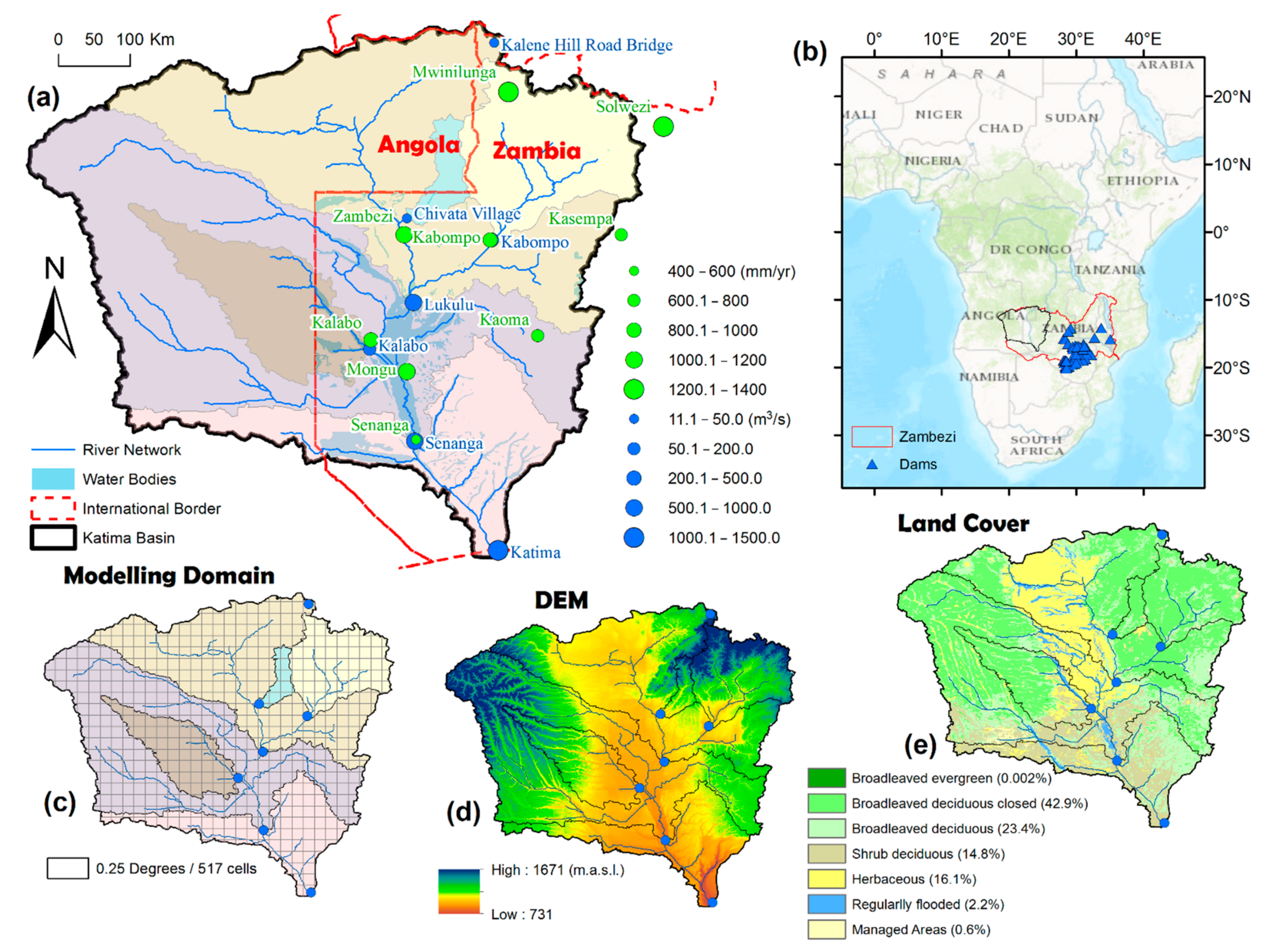
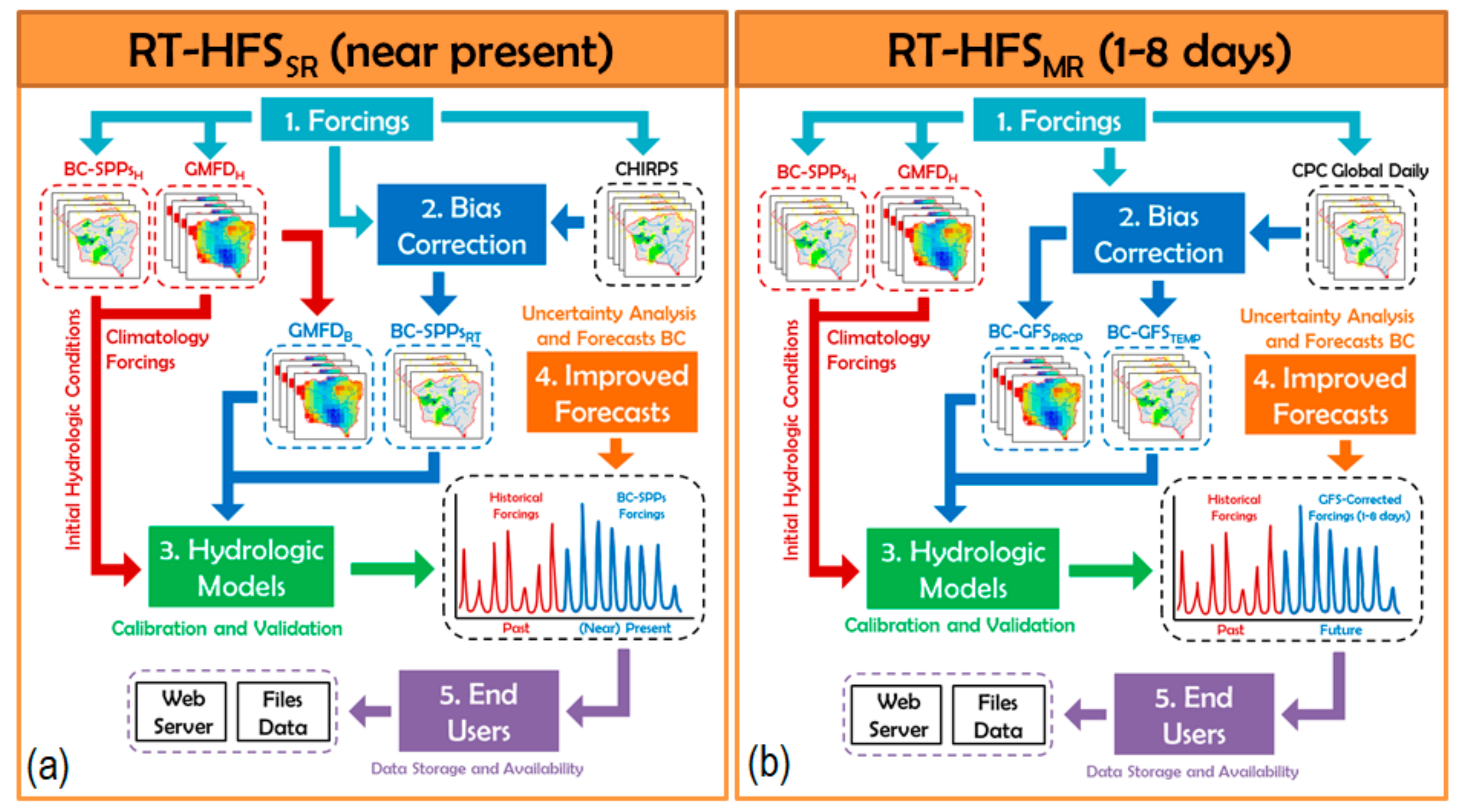
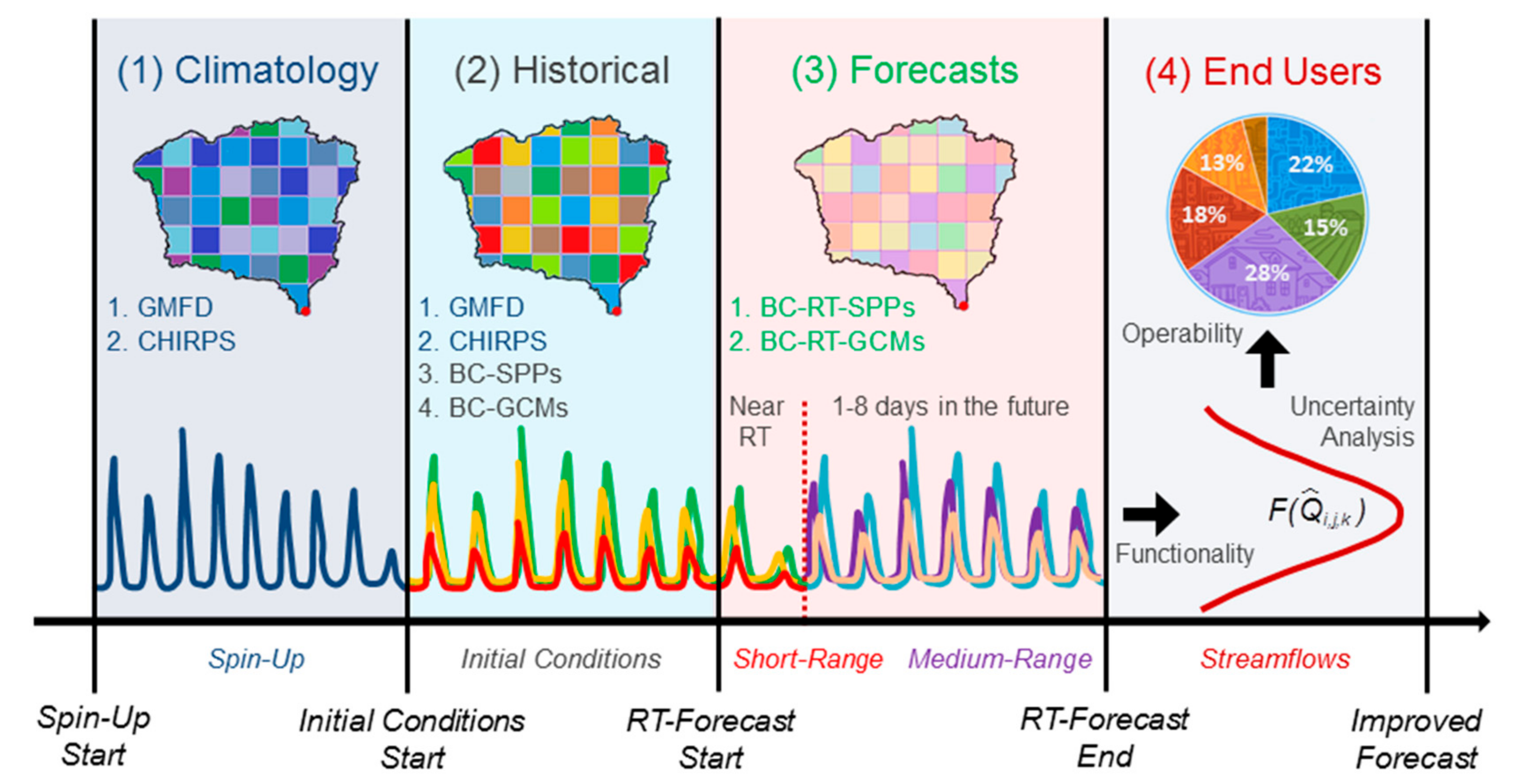

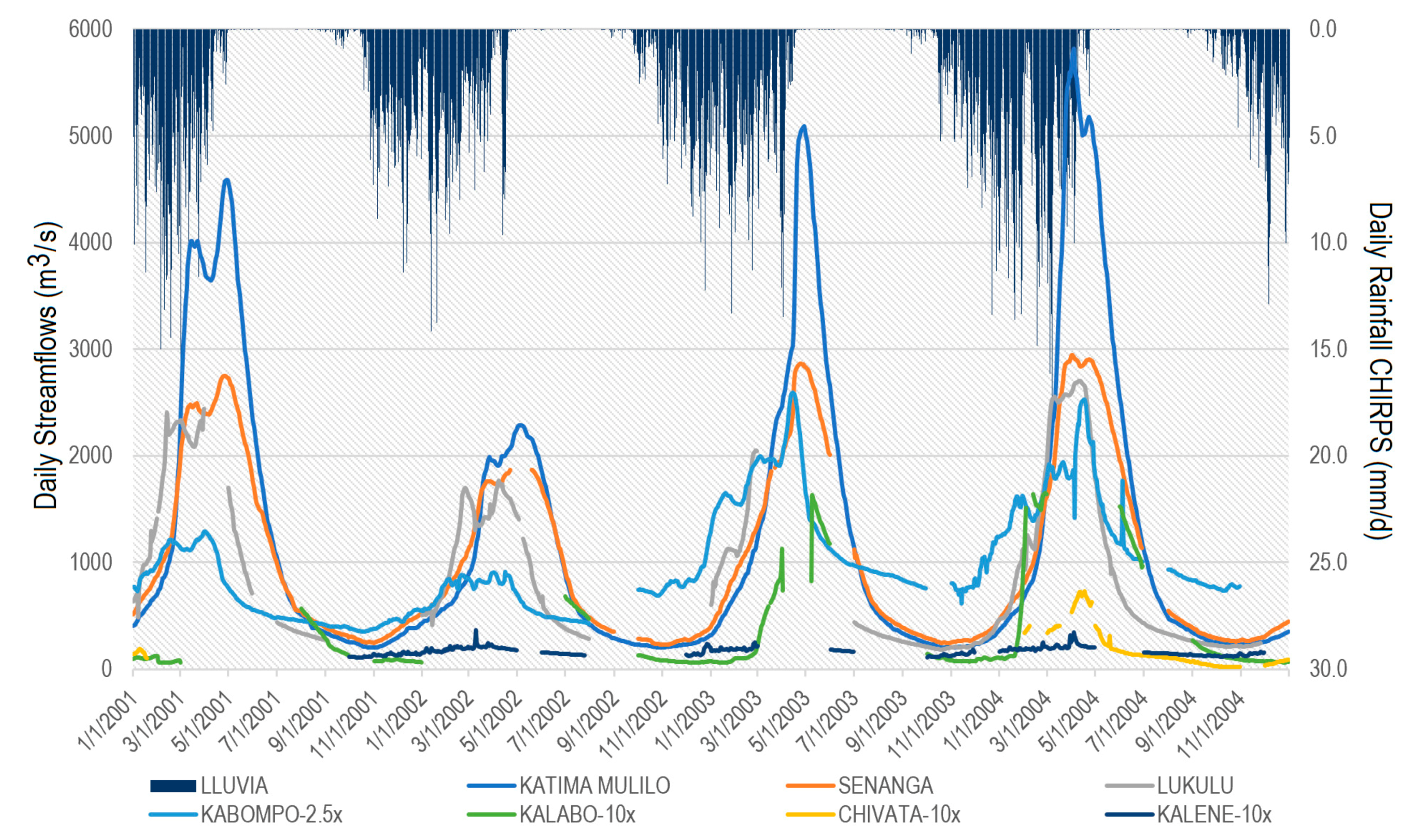
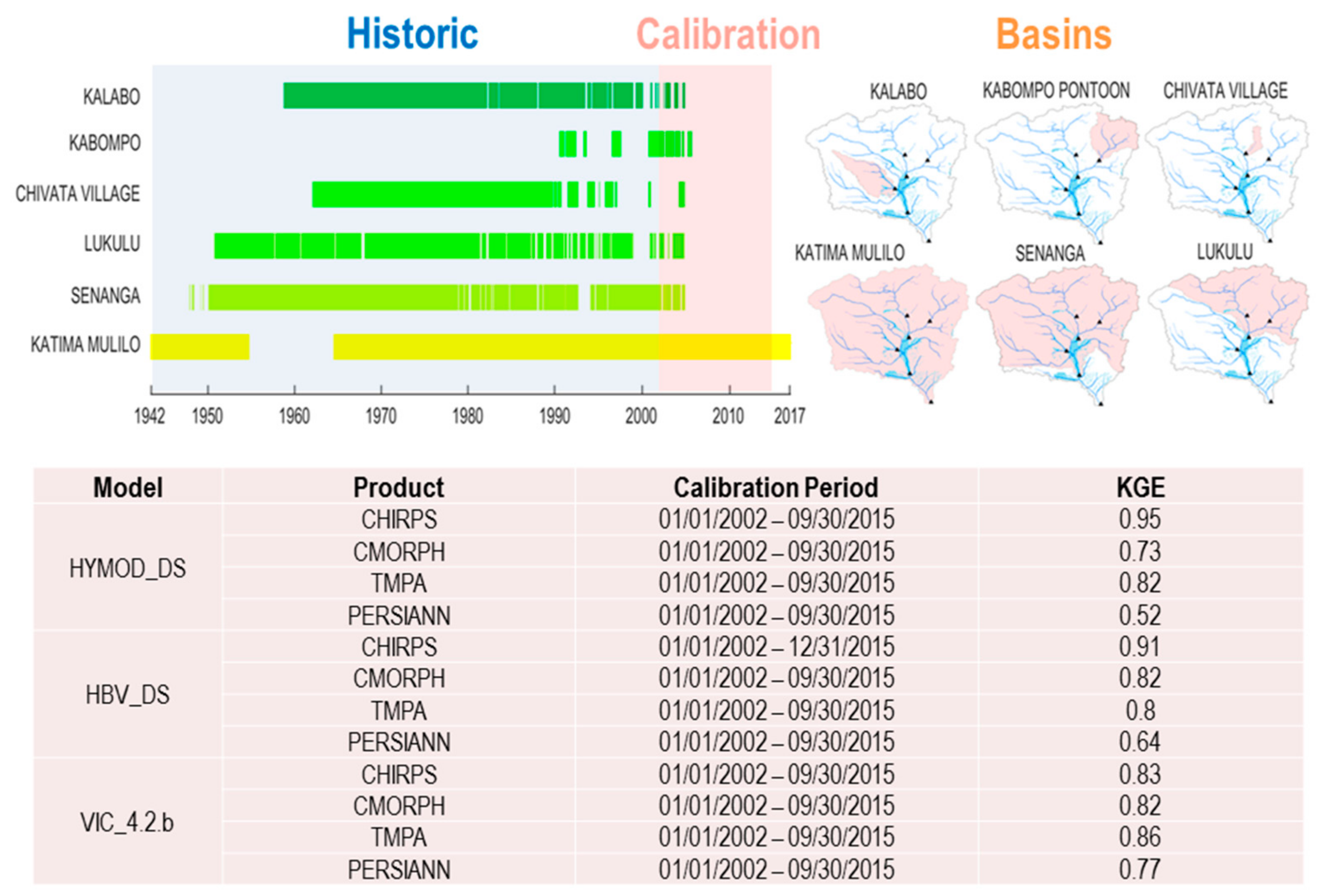
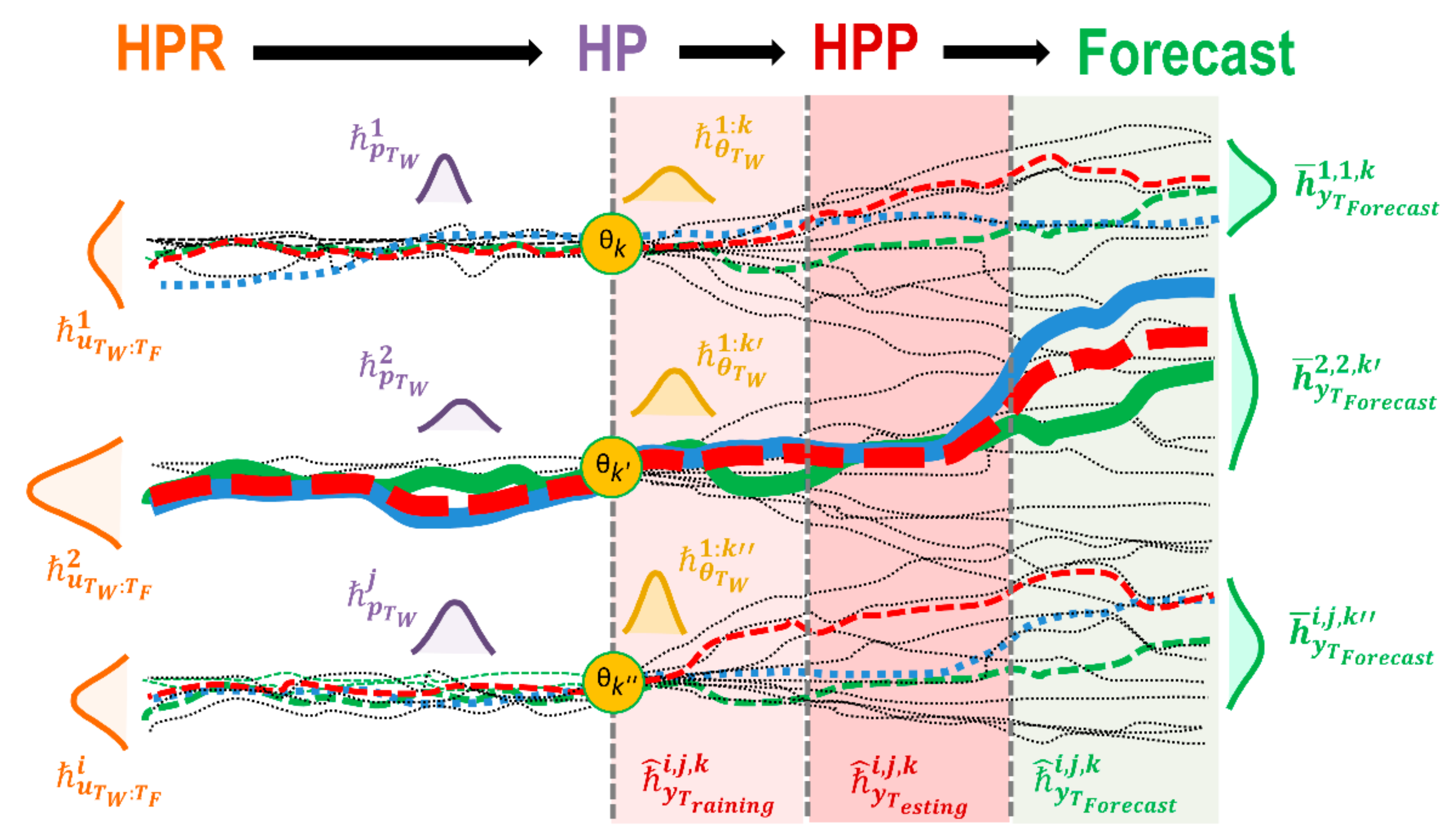
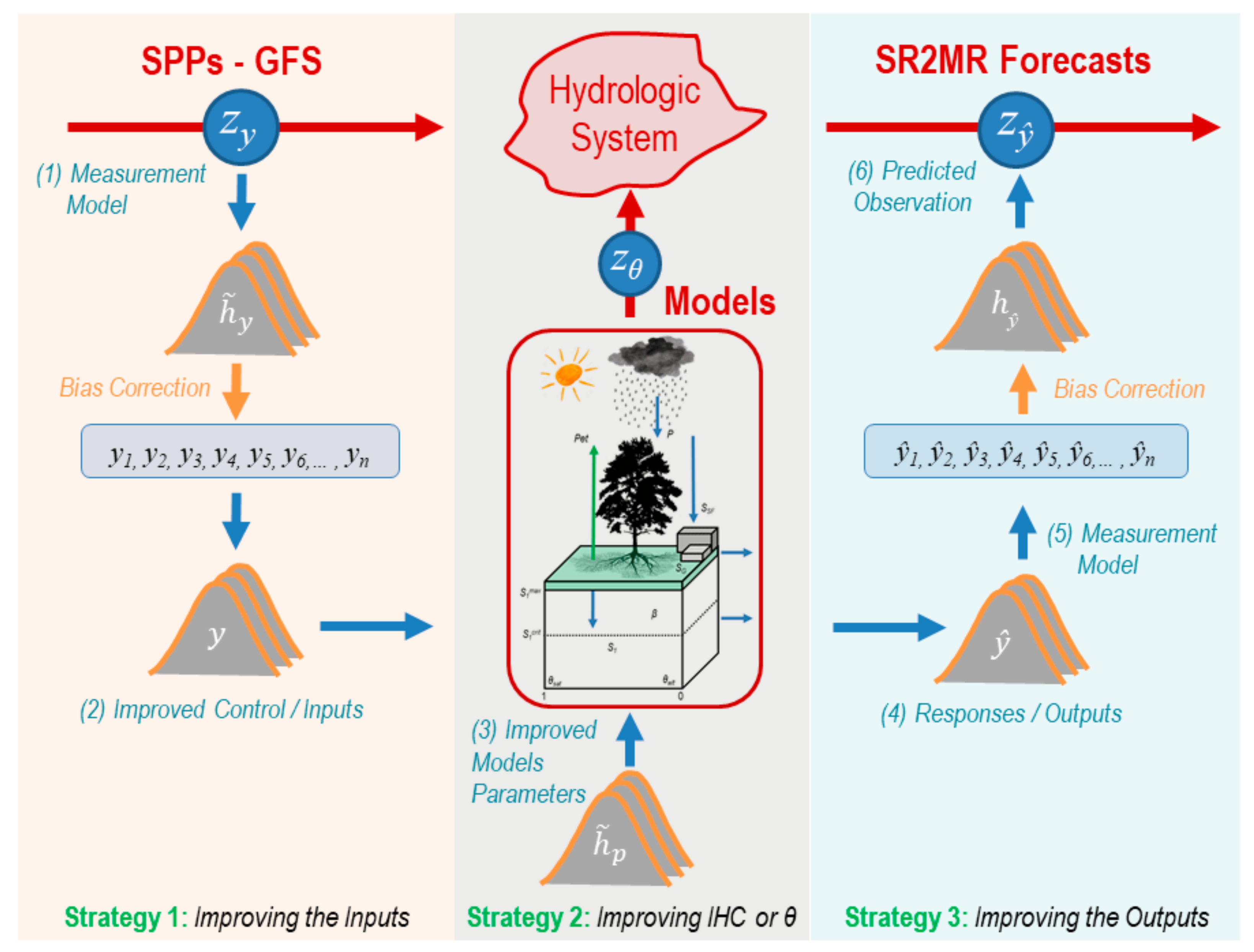
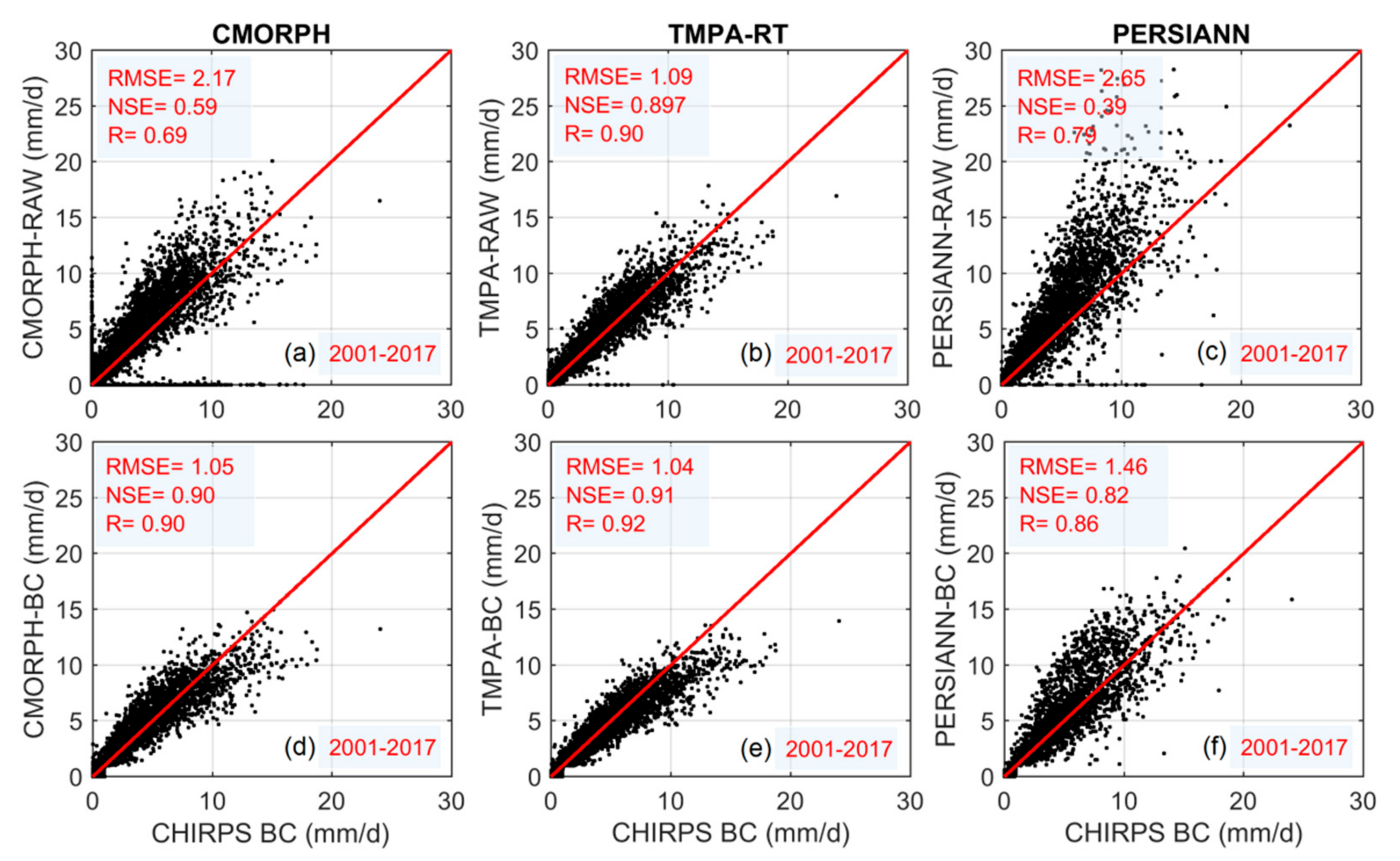
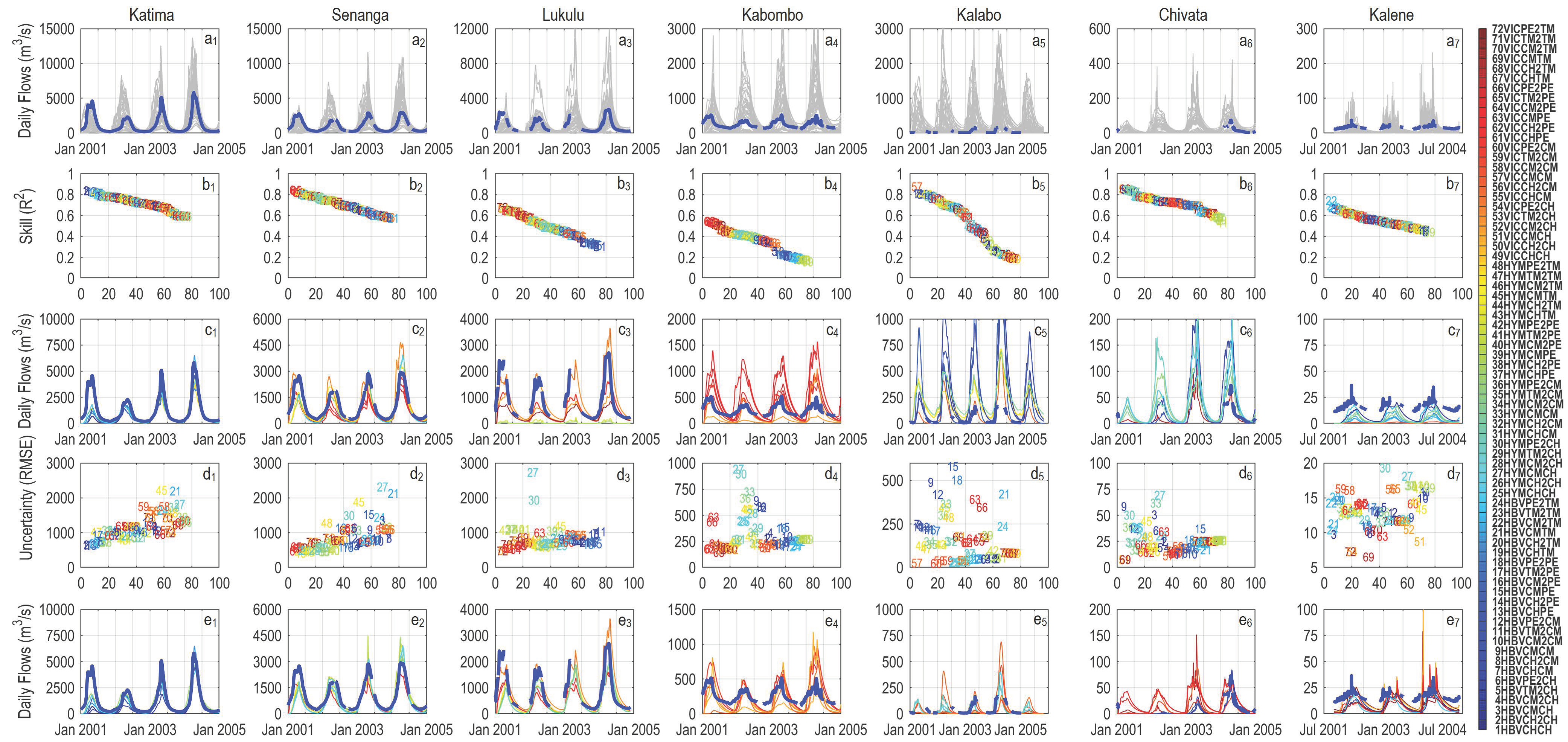
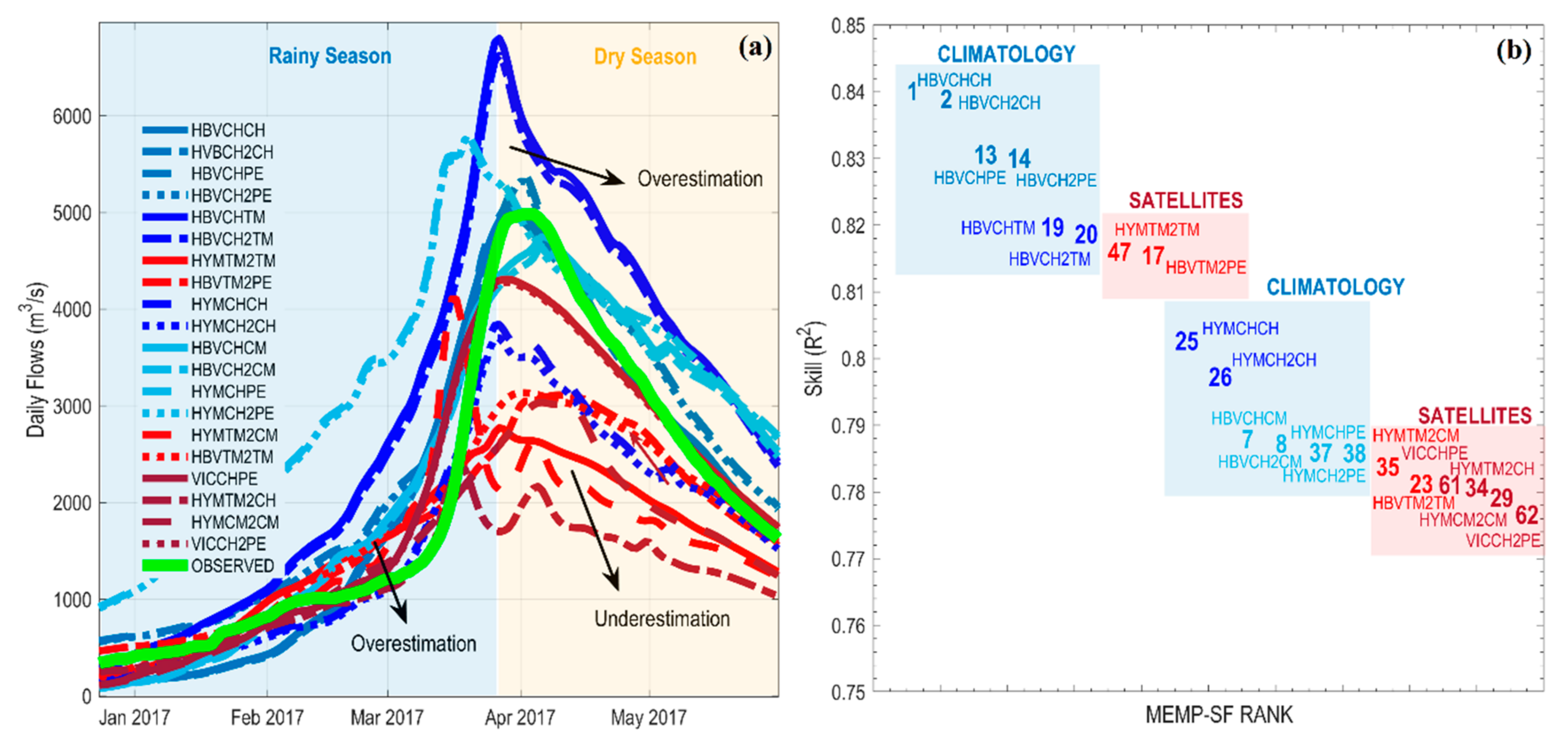
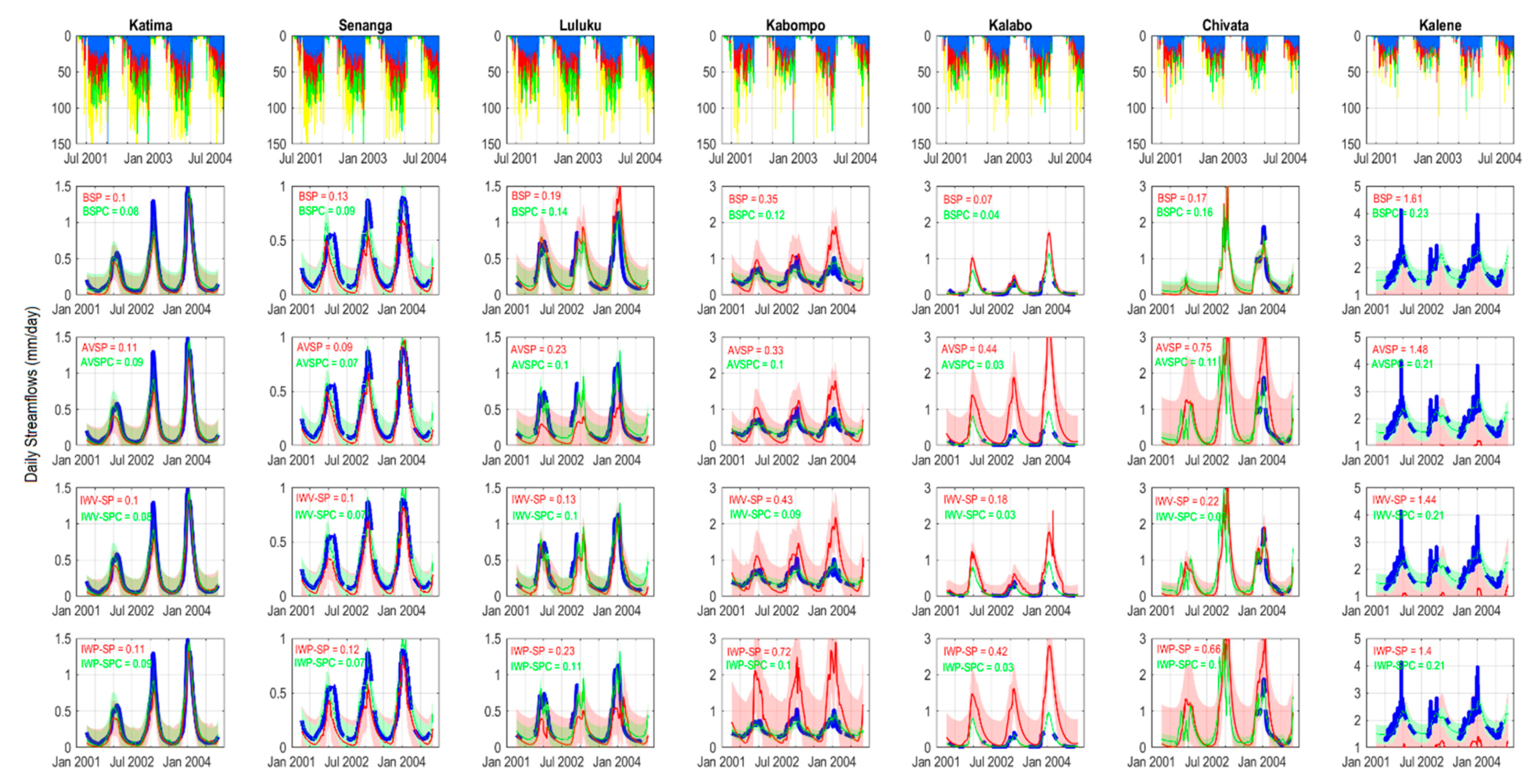
| Product | Institution | Spatial Resolution | Temporal Resolution | Global Coverage | Period |
|---|---|---|---|---|---|
| CHIRPS 1 [26] | UCSB | 0.25° × 0.25° | Daily | 50° N–50° S 180° E–180° W | 1981 to present |
| GMFD 2 [27] | Princeton | 0.25° × 0.25° | Daily | 50° N–50° S 180° E–180° W | 1981–2012 |
| PERSIANN-CCS 3 [31] | UCI | 0.25° × 0.25° | 3-hourly | 37.8° N–40.6° S 28.0° W–56.2° E | 1998 to present |
| CMORPH 4 [29] | NOAA-CPC | 0.25° × 0.25° | 3-hourly | 60° N–60° S 180° E–180° W | 1998 to present |
| TMPA-RT 5 [28] | NASA GES DISC | 0.25° × 0.25° | 3-hourly | 50° N–50° S 180° E–180° W | 1998 to present |
| GFS 6 [32] | NOAA-NCEI | 0.25° × 0.25° | 3-hourly | 90° N–90° S 180° E–180° W | 2014 to present |
| Katima Mulilo | GRDC | Streamgauge | Daily | 17.48° S–24.3° W | 1942 to present |
Publisher’s Note: MDPI stays neutral with regard to jurisdictional claims in published maps and institutional affiliations. |
© 2021 by the authors. Licensee MDPI, Basel, Switzerland. This article is an open access article distributed under the terms and conditions of the Creative Commons Attribution (CC BY) license (https://creativecommons.org/licenses/by/4.0/).
Share and Cite
Valdés-Pineda, R.; Valdés, J.B.; Wi, S.; Serrat-Capdevila, A.; Roy, T. Improving Operational Short- to Medium-Range (SR2MR) Streamflow Forecasts in the Upper Zambezi Basin and Its Sub-Basins Using Variational Ensemble Forecasting. Hydrology 2021, 8, 188. https://doi.org/10.3390/hydrology8040188
Valdés-Pineda R, Valdés JB, Wi S, Serrat-Capdevila A, Roy T. Improving Operational Short- to Medium-Range (SR2MR) Streamflow Forecasts in the Upper Zambezi Basin and Its Sub-Basins Using Variational Ensemble Forecasting. Hydrology. 2021; 8(4):188. https://doi.org/10.3390/hydrology8040188
Chicago/Turabian StyleValdés-Pineda, Rodrigo, Juan B. Valdés, Sungwook Wi, Aleix Serrat-Capdevila, and Tirthankar Roy. 2021. "Improving Operational Short- to Medium-Range (SR2MR) Streamflow Forecasts in the Upper Zambezi Basin and Its Sub-Basins Using Variational Ensemble Forecasting" Hydrology 8, no. 4: 188. https://doi.org/10.3390/hydrology8040188
APA StyleValdés-Pineda, R., Valdés, J. B., Wi, S., Serrat-Capdevila, A., & Roy, T. (2021). Improving Operational Short- to Medium-Range (SR2MR) Streamflow Forecasts in the Upper Zambezi Basin and Its Sub-Basins Using Variational Ensemble Forecasting. Hydrology, 8(4), 188. https://doi.org/10.3390/hydrology8040188







